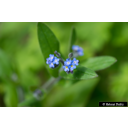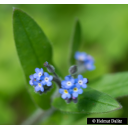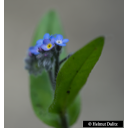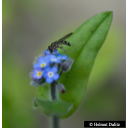Wissenswertes zum Taxon (Art, Unterart, Varietät...)
Myosotis sylvatica Ehrh. ex Hoffm. 1791
Boraginaceae - Boretschgewächse (APG IV)
Wald-Vergißmeinnicht
Quelle: Schmeil-Fitschen 2019
Verbreitung: Temperates Eurasien, Madeira
Verbreitungskarte Bundesamt für Naturschutz BfN
Größe: 0,15 - 0,45 m
Blütezeit: V - VII
Myosotis sylvatica Ehrh. ex Hoffm. - Accepted: Myosotis sylvatica Ehrh. ex Hoffm. bei Zander 2008; Familie: Boraginaceae (Zander 2008)
Myosotis sylvatica Ehrh. ex Hoffm. - Accepted: Myosotis sylvatica Ehrh. ex Hoffm. bei The Plant List (2010); Familie: Boraginaceae (APG III)
Myosotis sylvatica Hoffm. - Accepted: Myosotis sylvatica Hoffm. bei The Plant List (2014), version 1.1; Familie: Boraginaceae (APG III)
Myosotis sylvatica Hoffm. - Accepted: Myosotis sylvatica Hoffm. bei The Plant List (2014), version 1.1; Familie: Boraginaceae (APG IV)
Myosotis sylvatica Ehrh. ex Hoffm. - Accepted: Myosotis sylvatica Ehrh. ex Hoffm. bei The Plant List (2010); Familie: Boraginaceae (APG IV)
Myosotis sylvatica Ehrh. ex Hoffm. - Accepted: Myosotis sylvatica Ehrh. ex Hoffm. bei Plants of the World Online; Familie: Boraginaceae (APG IV)
Myosotis sylvatica Ehrh. ex Hoffm. - Synonym: Myosotis sylvatica Hoffm. bei Plants of the World Online; Familie: Boraginaceae (APG IV)
Myosotis sylvatica Ehrh. ex Hoffm. - Accepted: Myosotis sylvatica Ehrh. ex Hoffm. bei BfN Checklist Flora DE; Familie: Boraginaceae (APG IV)
Myosotis sylvatica Hoffm. - Accepted: Myosotis sylvatica Hoffm. bei World Flora Online - APG IV (Angiosperms); Familie: Boraginaceae (World Flora Online - APG IV (Angiosperms))
Myosotis sylvatica Ehrh. ex Hoffm. - Accepted: Myosotis sylvatica Ehrh. ex Hoffm. bei The Plant List (2010); Familie: Boraginaceae (APG III)
Myosotis sylvatica Hoffm. - Accepted: Myosotis sylvatica Hoffm. bei The Plant List (2014), version 1.1; Familie: Boraginaceae (APG III)
Myosotis sylvatica Hoffm. - Accepted: Myosotis sylvatica Hoffm. bei The Plant List (2014), version 1.1; Familie: Boraginaceae (APG IV)
Myosotis sylvatica Ehrh. ex Hoffm. - Accepted: Myosotis sylvatica Ehrh. ex Hoffm. bei The Plant List (2010); Familie: Boraginaceae (APG IV)
Myosotis sylvatica Ehrh. ex Hoffm. - Accepted: Myosotis sylvatica Ehrh. ex Hoffm. bei Plants of the World Online; Familie: Boraginaceae (APG IV)
Myosotis sylvatica Ehrh. ex Hoffm. - Synonym: Myosotis sylvatica Hoffm. bei Plants of the World Online; Familie: Boraginaceae (APG IV)
Myosotis sylvatica Ehrh. ex Hoffm. - Accepted: Myosotis sylvatica Ehrh. ex Hoffm. bei BfN Checklist Flora DE; Familie: Boraginaceae (APG IV)
Myosotis sylvatica Hoffm. - Accepted: Myosotis sylvatica Hoffm. bei World Flora Online - APG IV (Angiosperms); Familie: Boraginaceae (World Flora Online - APG IV (Angiosperms))
- Blütenfarbe
- hellblau
- Schutzstatus, Rote Liste
- Ungefährdet in DE (*)
- Lebensform
- krautig, terrestrisch, einjährig
- Bodenbedingungen
- frische (feuchte), Nährstoff- und basenreiche, oft kalkarme, locker-humose Lehmböden, Mullböden
- Lichtbedingungen
- Halbschattpflanze
- Lichtbedingungen (Symbole)
- ◐
- Natürliches Vorkommen (Habitat)
- Hochstaudengebüsch, Wald- und Wegränder, Waldschläge, Viehlägerplätze
- Häufigkeit des Auftretens (in welcher Region?)
- zerstreut aber gesellig
- Kommentar zur Ökologie
- Nährstoffzeiger, auch Kulturformen als Zierpflanzen
- Vegetationstypus und Synökologie (Pflanzengesellschaft)
- in tieferen Lagen vor allem im Epilobion ang. und Atropion, Atropetalia-Ordnungscharakterart, in Hochlagen auch in Arrhenatheretalia-Ges. oder im Adenostylion, Ord. Atropetalia
- Einschränkungen bzgl. Bodenbedingungen
- nicht salzertragend
- Sicherheitshinweis
- enthält Pyrrolizidinalkaloide
- Status der Einbürgerung
- indigen, Status nach BfN: I = etablierte Indigene und Archäobiota
- Biotoptyp
- Rabatten
- Nektar
- mittel
- Pollen
- wenig
Erhardt, W., Götz, E., Bödeker, N. & Seybold, S. (2008): Der große Zander. Enzyklopädie der Pflanzennamen. Band 2. Arten und Sorten. Eugen Ulmer KG, Stuttgart (Hohenheim), 18. Aufl., 2103 S.;
Maurizio, Anna et al. (1982): Nektar und Pollen - die wichtigsten Nahrungsquellen der Honigbiene. 4. Ehrenwirth, München, 3, überabeitete Auflage;
Pritsch, Günter et al. (2007): 200 Trachtpflanzen erkennen und bewerten.. Kosmos, Stuttgart;
The International Plant Names Index (2009). Published on the Internet http://www.ipni.org; Courtesy to IPNI, 2009. Exported from IPNI at date: 2009-09-22 20:17:51;
Maurizio, Anna et al. (1982): Nektar und Pollen - die wichtigsten Nahrungsquellen der Honigbiene. 4. Ehrenwirth, München, 3, überabeitete Auflage;
Pritsch, Günter et al. (2007): 200 Trachtpflanzen erkennen und bewerten.. Kosmos, Stuttgart;
The International Plant Names Index (2009). Published on the Internet http://www.ipni.org; Courtesy to IPNI, 2009. Exported from IPNI at date: 2009-09-22 20:17:51;
Letzte Aktualisierung:
Taxonomische Aktualisierung: Helmut Dalitz am: 28.5.2021Aktualisierung des Steckbriefs: Aleta Neugebauer; Christiane Dalitz; Helmut Dalitz; imported by Helmut Dalitz; zuletzt von: Aleta Neugebauer am: 18.6.2025 (HOH-1106077)




